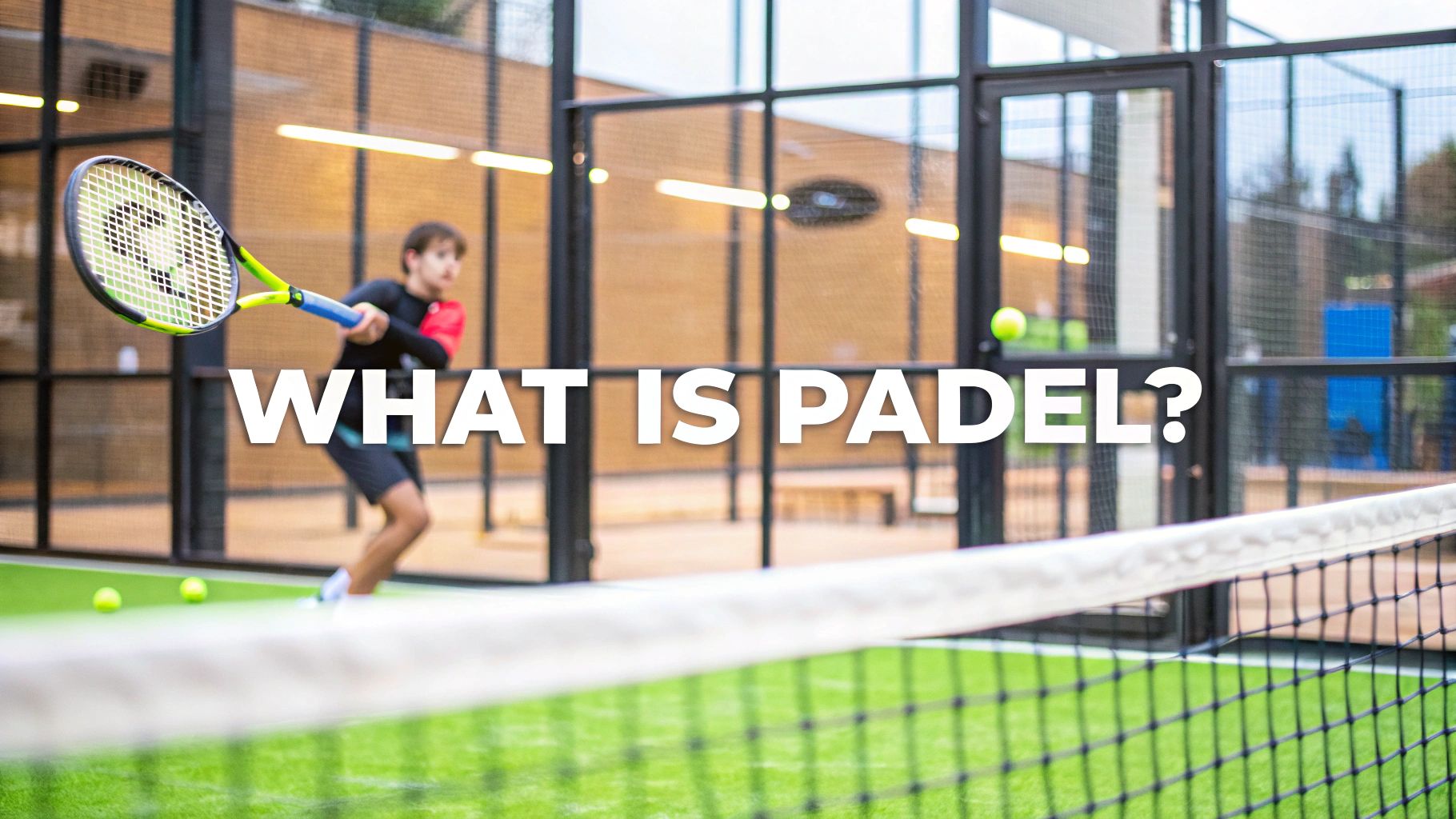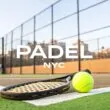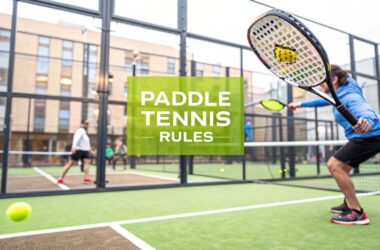So, what exactly is this sport you keep hearing about? Simply put, padel is an incredibly fun racket sport that cherry-picks the best parts of tennis and squash and blends them into something new and exciting. It's played in doubles on a court that's smaller than a tennis court and enclosed by glass walls, which are very much in play. This little twist leads to some seriously entertaining and long-lasting rallies.
Why Everyone Is Talking About Padel
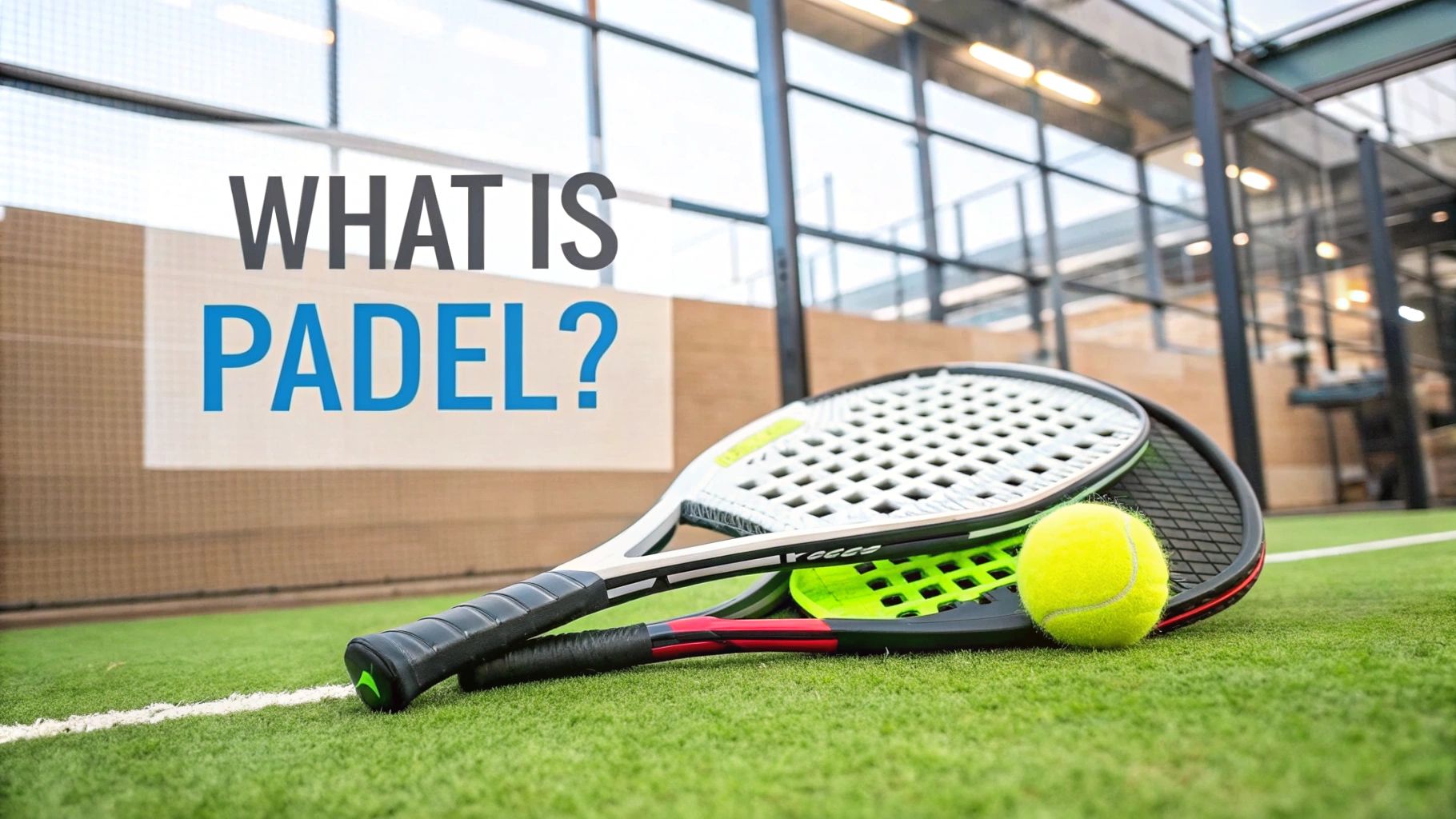
If you've noticed a growing buzz around a new racket sport, you're definitely not imagining things. Padel has exploded onto the scene, charming millions with gameplay that’s both fast-paced and surprisingly easy to get into.
Some people call it 'tennis with walls,' while others describe it as 'squash in the sun with a partner.' Both are pretty accurate. This unique combination makes padel less physically demanding than its cousins, and way less intimidating for newcomers.

Buy the best padel gear to level up your next game!
CHECK OUT this deal from Padel Market!Get ready to take your game to the next level with the latest padel gear from Padel Market! Fast EU and Worldwide Shipping
The real magic is in its simplicity and social vibe. The court is compact, the rallies are long, and the learning curve is refreshingly gentle. Most people can grab a paddle and be playing a proper, fun game within their first hour on the court.
An Unprecedented Global Expansion
Padel is widely considered the fastest-growing sport on the planet, and it's not hard to see why. The growth stats are genuinely mind-boggling. In just one recent year, a staggering 3,282 new padel clubs popped up in over 90 countries—that works out to a new club opening its doors every 2.5 hours.
This boom has catapulted the total number of courts past 50,000 worldwide. And here’s the kicker: an incredible 92% of new players come back for more after their first time playing. It’s that addictive. If you're curious, you can explore more data on this rapid growth to see just how fast it's taking over.
This isn't just about building courts; it's about building communities. Padel clubs are quickly becoming the new social hotspots where people meet, compete, and just have a great time.
To give you a quick snapshot, here’s padel in a nutshell:
Padel at a Glance
| Characteristic | Description |
|---|---|
| Players | Always played in doubles (2 vs. 2). |
| Court | A 10×20 meter rectangle enclosed by glass and mesh walls. |
| Serve | Must be served underhand, making it easy to learn. |
| Walls | The back and side walls are part of the game. |
| Scoring | Same as tennis (15, 30, 40, deuce, game). |
| Core Appeal | Highly social, easy to pick up, and strategically engaging. |
As you can see, the game is designed for fun and interaction from the ground up.
What Makes Padel So Appealing
The secret to padel's charm lies in a few core features that put fun and teamwork ahead of raw power and athleticism. This is a huge reason why so many people are happily trading their tennis rackets for padel paddles.
- Easy to Learn: With an underhand serve and a smaller court, you can start rallying and having fun almost immediately. No steep learning curve here.
- Highly Social: It's a doubles-only game, so communication and teamwork are built right in. It’s the perfect recipe for a fun, interactive atmosphere.
- Strategic Gameplay: Using the walls adds a whole new dimension of strategy that you just don't get in tennis. It makes every point a dynamic and engaging puzzle.
Because of all this, learning what is padel sport is your first step toward finding a hobby you'll absolutely love. Its perfect mix of accessibility and strategic depth makes every game a blast.
The Padel Court and Your Essential Gear
Before you ever swing a racket, it helps to get a feel for the arena. The court and the gear are what give padel its unique character, directly shaping the game's fast-paced, strategic flow.
Picture a tennis court, but smaller, cozier, and boxed in by glass walls and mesh fencing. That's a padel court in a nutshell. It measures 10 meters wide by 20 meters long, a much more compact space than its tennis counterpart. This design naturally brings players closer together, demanding quick reflexes and constant communication with your partner.
But those walls aren't just for show. They're a fundamental part of the game.
In padel, the walls aren't obstacles; they're your allies. A ball that ricochets off the back glass is still in play, giving you a chance to turn a defensive scramble into a clever, unexpected attack. It makes the game feel like a three-dimensional chess match on your feet.
Most padel courts use artificial turf as the playing surface. While it might all look the same, understanding the different artificial grass types can give you a heads-up on how the ball will bounce and how your feet will grip.
Your Tools for the Game
Now for the fun part: the gear. The good news is, you don't need a lot to get started. All it really takes is a racket, a ball, and a decent pair of court shoes. The equipment is purpose-built to be user-friendly, encouraging long, exciting rallies right from day one.
The padel racket, or 'pala' as it's known in Spanish, is a whole different beast from a tennis racket.
- Solid and Stringless: Instead of strings, it has a solid foam core wrapped in a composite shell like fiberglass or carbon fiber.
- Perforated Surface: The face is covered in holes. This isn't just for looks; it cuts down on air resistance and helps you put a little extra spin on the ball.
- Shorter and Thicker: It’s more compact than a tennis racket, which makes it incredibly easy to manage and control.
This design deliberately trades raw, overwhelming power for finesse and precision. It’s a big reason why beginners can pick up the game so quickly and enjoy satisfying rallies almost immediately.

Buy the best padel gear to level up your next game!
CHECK OUT this deal from Padel Market!Get ready to take your game to the next level with the latest padel gear from Padel Market! Fast EU and Worldwide Shipping
The Padel Ball and Footwear
The ball might look just like a standard tennis ball, but there’s a key difference: it has less internal pressure. This small tweak is a game-changer. It causes the ball to bounce a bit slower and lower, giving you that extra split second to get in position and plan your shot. It's a key ingredient in the long, strategic points that make padel so addictive.
Finally, let's talk about shoes. You can technically start with any pair of trainers, but you'll quickly appreciate proper court shoes made for racket sports. Padel involves a ton of sharp, lateral movements and quick pivots. The right shoes give you the side-to-side support you need to move confidently and help keep your ankles safe on the turf.
Understanding the Basic Rules of Padel
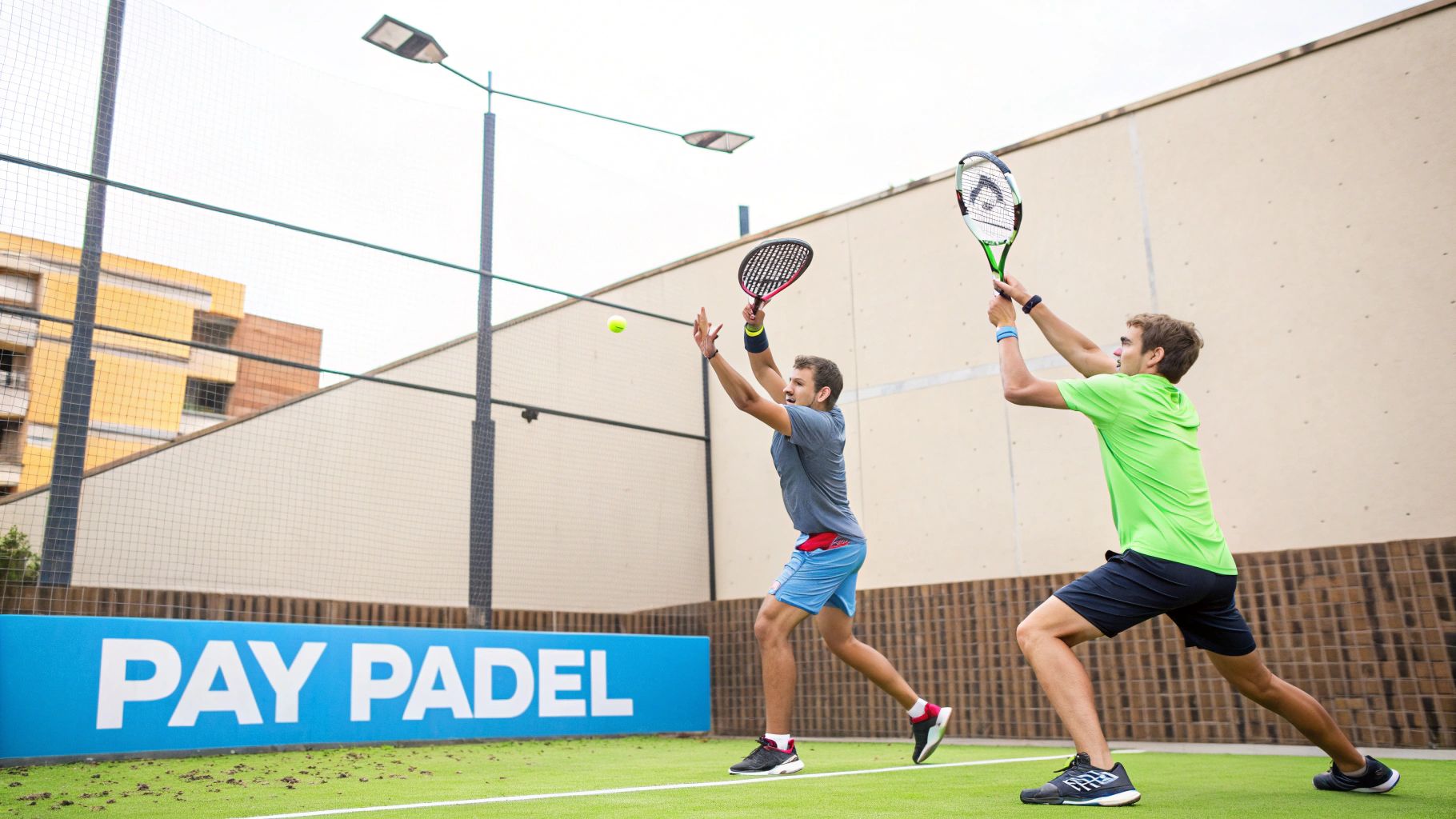
One of the best things about padel is how simple the rules are. They're designed to get you on the court and having fun right away, without needing to study a massive rulebook. It all really boils down to three key things: the serve, the scoring, and how you use the walls.
Once you get a feel for these fundamentals, you'll be more than ready for your first match. Let's break each one down so you can step onto the court with total confidence.
The Simple Underhand Serve
Forget the powerful, complex overhead serves you see in tennis. The padel serve is a different beast entirely—it's gentle, straightforward, and much easier for beginners to get the hang of. This immediately removes one of the biggest hurdles for new players.
The process is refreshingly simple. You just let the ball bounce once behind the service line before you hit it. The most important part? You have to make contact with the ball at or below your waist level. This underhand motion isn't about power; it's about consistency, making it much easier to start a good rally. And just like in tennis, you get two serves, so there's no pressure to nail it on the first try.
This one rule change really levels the playing field, making sure points are won with smarts and teamwork instead of just one blistering serve.
Scoring Just Like Tennis
If you've ever watched or played tennis, you've got a major head start. The scoring system in padel is identical, which makes it feel instantly familiar to a lot of new players.
You count points just like this: 15, 30, 40, and then game. If both teams hit 40-40, that's "deuce." From there, a team has to win two points in a row to take the game. A full match is usually the best of three sets, and the first team to win six games wins the set.
Because the scoring is so familiar, you can spend less time trying to remember the score and more time focusing on your shots and coordinating with your partner.
Using the Walls for Strategic Play
This is where padel really shines and shows its unique personality. Those glass walls aren't just there to keep the ball in—they are an active, strategic part of the game. Grasping this concept is probably the most important part of understanding what is padel sport.
Here's the basic idea: the ball is still in play if it hits any of the glass walls after it has bounced once on your side of the court. So, if your opponent smashes a shot that bounces on your turf and then flies off the back glass, you can still play it back over the net.
This opens up a whole new world of strategic possibilities:
- Defensive Plays: Let a fast shot hit the back wall. This slows it down and gives you more time to set up your return.
- Creative Angles: You can play the ball off the side wall to send it flying back at your opponents from a totally unexpected angle.
Getting comfortable with using the walls is the key to unlocking the true strategic depth of padel. For a deeper dive, you can read more about the complete rules of padel and learn how to use them to your advantage.
Alright, so you’ve got the rules down. Now it's time for the fun part: stepping onto the court for your first game and thinking about how to actually win a point.
Let me give you a piece of advice that will save you a lot of frustration. Padel isn't about blasting the ball as hard as you can. It’s a game of wits, placement, and most importantly, teamwork. If you go in trying to hit flashy winners, you’re going to have a bad time.
For your first few games, just focus on two things: keeping the ball in play and communicating with your partner. The real magic of padel is that a smart, coordinated team will almost always beat a pair of ungaurded power-hitters.
Core Strategies for Your First Match
Padel is a game of patience. Seriously. Think of it less like tennis and more like a chess match where you're trying to manoeuvre your opponents out of position. Your primary goal is to build points, wait for an opening, and patiently force your opponents to make a mistake.
A huge part of this is controlling the net. In most rallies, the team that owns the net controls the point. But don't just blindly rush forward. You have to earn your spot at the net by hitting shots that push your opponents back toward the glass, which opens up the court for you to move in and attack.
This is where that teamwork I mentioned becomes critical. You and your partner need to move as a single unit, almost like you're tied together by an invisible rope. When one person moves up, the other moves up with them. If one covers the middle, the other protects the line. This kind of synchronized movement shuts down the angles and prevents easy winners for the other team.
Must-Know Shots for Beginners
While there’s a whole library of shots in padel, you only need a couple to get started. The first, and maybe most important, is the bandeja. It’s not a smash; it’s a defensive overhead shot. When your opponents lob the ball over you, the bandeja is your tool to hit a deep, relatively slow ball that keeps a low bounce. This gives you time to get back into position at the net instead of scrambling backward.
Another game-changing tactic is learning to love the walls. When someone rips a ball past you, don't panic. Just let it hit the back glass. The wall will absorb most of the pace, slowing the ball down and giving you a much calmer, more controlled shot to send back over the net. Treating the glass as your friend is a major turning point for every new player.
Key Takeaway: If you remember one thing, make it this: consistency wins games. Just focus on getting the ball back over the net one more time than your opponents. Work with your partner and let them be the ones to make the unforced errors. You’ll be surprised how many points you win with this simple mindset.
This infographic lays out the essential gear that helps you put these strategies into play.
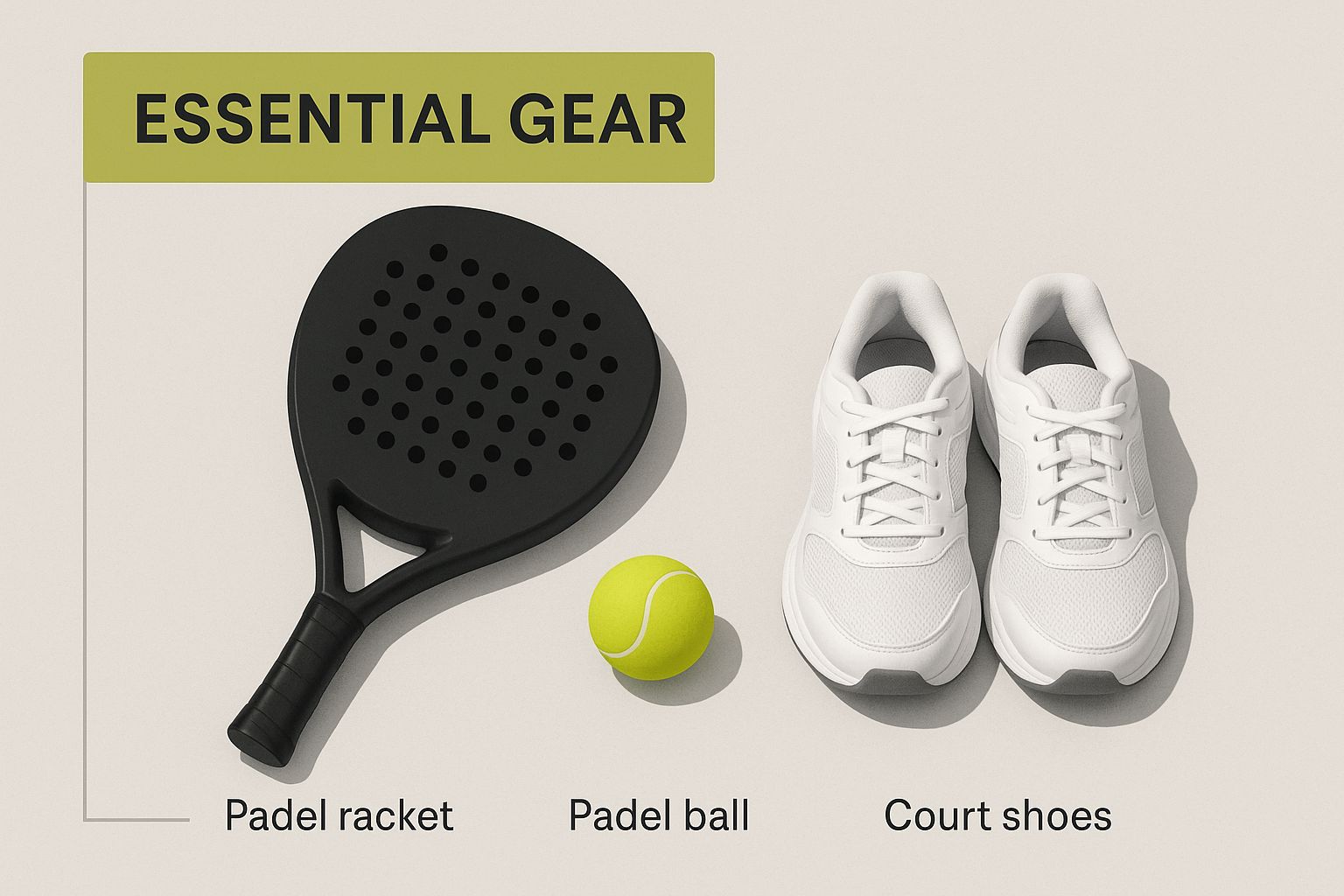
Having the right racket and a good pair of shoes makes a real difference in how well you can move and execute shots. If you’re just starting out, check out our guide on the best padel racket for beginners for some solid recommendations.
This strategic depth is a big reason why padel is exploding globally. The number of major international tournaments recently shot up from 71 to 132 in a single year—that's an 86% jump! We’re also seeing events like the European Championships feature 59 national teams, proving this is no longer just a Spanish fad.
The Health and Social Perks of Playing Padel
Sure, the thrilling rallies and clever strategies are what get most people hooked, but the real magic of padel happens off the court, too. It’s so much more than just a game—it's a massive boost for your physical health and your social life. People show up for the sport and end up staying for the amazing community and lifestyle it builds.
One of padel's best-kept secrets is that it delivers an incredible cardiovascular workout without the punishing impact of other sports. The smaller court and artificial turf are a whole lot kinder to your joints, especially your knees and ankles, than the unforgiving hard courts of tennis or pounding the pavement for a run.
This means you can play longer, play more often, and have a much lower risk of getting sidelined by injuries. It’s a fantastic sport for just about anyone, from young kids burning off energy to active seniors who want to stay sharp and agile.
A Full-Body Workout in Disguise
Padel is one of those brilliant activities that gets you seriously fit without ever feeling like a chore. The constant, fast-paced action and dynamic movement give you a workout that engages your entire body. You're always lunging, twisting, and making short sprints, which is perfect for building both strength and stamina.
- Razor-Sharp Reflexes: The speed of the ball and the close quarters sharpen your reaction time like nothing else.
- Better Coordination: You're constantly tracking the ball, moving in sync with your partner, and timing your shots—a recipe for incredible hand-eye coordination.
- A Rock-Solid Core: Every single shot, from a simple groundstroke to a powerful bandeja, fires up your core muscles for stability and power.
Padel is a perfect example of functional fitness. You're not just mindlessly lifting weights in a gym; you're teaching your body to move in ways that make you more agile and balanced in everyday life.
If you're serious about taking your game to the next level, looking into fitness testing for sport can give you game-changing insights into your personal strengths and weaknesses.
The Social Heart of the Game
While the health benefits are fantastic, the social side of padel is where it truly shines. It's arguably the sport's greatest strength. The compact court and doubles-only format create a uniquely friendly and interactive vibe. You’re right there with your partner and opponents, close enough to chat and share a laugh between points. It builds a sense of camaraderie that’s tough to find in more solitary sports.
Padel clubs are quickly becoming the new local hangouts—vibrant hubs where friendships are made, families spend quality time together, and even companies come for a fun team-building day. The atmosphere is so welcoming that it’s incredibly easy for newcomers to find a game and a partner, creating a real community where everyone feels like they belong.
Common Questions From New Padel Players
If you're new to the game, you've probably got a few questions bubbling up. Don't worry, everyone does! We've pulled together the most common things beginners ask to help clear things up before you step on the court for the first time.
Do I Need A Partner To Start Playing Padel?
Nope, not at all. It's true that padel is always a doubles game, but you don't need to show up with a full squad.
Most clubs and booking apps are built to connect players. It's super easy to find and join "open matches" or beginner clinics where you'll get paired up with others who are also just starting out. The community is famously friendly and welcoming, so you'll find a game in no time.
Is Padel An Expensive Sport To Play?
Padel is actually surprisingly affordable. Your main cost is renting the court, but here's the great part: you split that cost between four players. This often makes it cheaper per person than a game of tennis.
Beginner rackets are also very reasonably priced, and a lot of clubs offer rental equipment. This means you can get a feel for the game before you even think about buying your own gear.
The ability to rent equipment and split court fees makes padel one of the most accessible racket sports. You can get a full game experience without a big upfront investment.
How Quickly Can I Learn To Play Padel?
Honestly? You'll be rallying and having a blast within your first hour on the court. This is one of padel's biggest selling points.
The learning curve is incredibly gentle. Thanks to the smaller court, the simple underhand serve, and the forgiving racket, even total beginners can play a real match from day one. That instant gratification is a huge reason why so many people get completely hooked right away.





